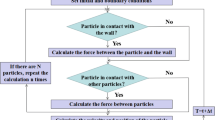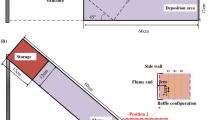Abstract
Debris flows surge downslope carrying destructive energy and can result in long runout distances. Structural mitigation is commonly installed along the flow path to impede debris flow mobility and protect downstream facilities. An array of baffles is a structural countermeasure frequently designed using empirical methods or prescribed to impede debris flow; nonetheless, its influence on reducing mobility is not well understood. A 5-m-long flume model is used to conduct a series of tests to systematically study the effects of varying baffle height, number of rows, spacing between rows, and degree of transverse blockage on mobility. Froude scaling is adopted to characterize initial upstream conditions. Debris runout, overflow, and frontal velocity reduction resulting from each baffle configuration used are examined. Experimental results reveal that it is imperative to adopt baffle heights taller than the approach flow depth (h) in order to suppress overflow and reduce runout. Adopting 1.5 h-tall baffles can reduce runout and peak overflow depth by 19 and 20 % compared to short baffles (0.75 h), respectively. A single row of baffles is ineffective in reducing frontal debris velocity, whereas increasing the array to three rows leads to 65 % reduction in runout and up to 57 % reduction in frontal velocity. Increasing spacing between successive rows from 0.25w to 0.5w can reduce runout by up to 37 %.

















Similar content being viewed by others
References
Arattano M, Deganutti AM, Marchi L (1997) Debris flow monitoring activities in an instrumented watershed on the Italian Alps. 1st International Conference on Debris-Flow Hazards Mitigation: mechanics, prediction and assessment. ASCE, San Francisco, CA, pp 506–515
Choi CE, Ng CWW, Law RPH, Song D, Kwan JHS, Ho KKS (2013a) Investigation of baffle configuration on landslide debris impedance. Canadian Geotechnical Journal (re-submitted with minor corrections)
Choi CE, Ng CWW, Song D, Kwan JHS, Shiu HYK, Ho KKS, Koo RCH (2013b) Flume investigation of landslide debris resisting baffles. Canadian Geotechnical Journal (re-submitted with minor corrections)
Choi CE (2013) Flume and discrete element investigation of granular flow mechanisms and interaction with baffles. PhD Thesis, The Hong Kong University of Science and Technology
Chu T, Hill G, McClung DM, Ngun R, Sherkat R (1995) Experiments on granular flows to predict avalanche runup. Can Geotech J 32(2):285–295
Costa JE (1984) Physical Geomorphology of Debris Flows: Developments and Applications of Geomorphology. Springer, Berlin
Cosenza E, Cozzolino L, Pianese D, Fabbrocino G, Acanfora M (2006) Concrete structures for mitigation of debris-flow hazard in the Montoro Inferiore Area, Southern Italy. 2nd International Congress, IFSC, Naples, Italy, pp 1–12
Gray JMNT, Tai YC, Noelle S (2003) Shock waves, dead zones and particle-free regions in rapid granular free-surface flows. J Fluid Mech 491:161–181
Hákonardóttir KM, Jóhannesson T, Tiefenbacher F, Kern M (2001) A laboratory study of the retarding effect of braking mounds in 3, 6 and 9 m long chutes, Report No. 01007. Reykjavík, Veðurstofa Íslands
Hauksson S, Pagliardi M, Barbolini M, Jóhannesson T (2007) Laboratory measurements of impact force of supercritical granular flow against mast-like obstacles. Cold Reg Sci Technol 49(1):54–63
Heim A (1932) Landslides and human lives (Bergsturz und Menschenleben). Bi-Tech Publishers, Vancouver, British Columbia, Canada
Hübl J, Suda J, Proske D, Kaitna R, Scheidl C (2009) Debris Flow Impact Estimation. 11th International Symposium on Water Management and Hydraulic Engineering, WMHE, Ohrid, Macedonia, pp 137–148
Hungr O (1981) Dynamics of rock avalanches and other types of mass movements. PhD Thesis, University of Alberta
Hungr O, Leroueil S, Picarelli L (2013) The Varnes classification of landslide types, an update. landslides DOI 10.1007/s10346-013-0436-y
Ikeya H, Uehara S (1980) Experimental study about the sediment control of slit Sabo dams. J Jpn Erosion Control Eng Soc 114:37–44
Iverson R (1997) The physics of debris flows. Rev Geophys 35(3):245–296
Iverson R, Vallance J (2001) New views of granular mass flows. Geology 29(2):115–118
Jóhannesson T, Gauer P, Issler D, Lied K (2009) The design of avalanche protection dams recent practical and theoretical developments. European Commission, Belgium
Lo DOK (2000) Review of natural terrain landslide debris-resisting barrier design: GEO-Report No. 104. Geotechnical Engineering Office, HKSAR
Mancarella D, Hungr O (2010) Analysis of run-up of granular avalanches against steep, adverse slopes and protective barriers. Can Geotech J 47(8):827–841
Mizuyama T (2008) Structural countermeasures for debris flow disasters. Int J Erosion Control Eng 1(2):38–43
Olivares L, Picarelli L (2006) Modelling of flowslides behaviour for risk mitigation. 6th Int. Conference on Physical Modelling in Geotechnics, Hong Kong, pp 99-113
Rickenmann D (1999) Empirical relationships for debris flows. Nat Hazards 19(1):47–77
Salm B (1987) Snow, avalanches and avalanche protection (lecture notes). Swiss Federal Institute of Technology in Zurich (in German)
Scheidegger AE (1973) On the prediction of the reach and velocity of catastrophic landslides. Rock Mech 5:231–236
United States Federal Highway Administration (2006) Hydraulic design of energy dissipaters for culverts and channels: Report No. FHWA-NHI-06-086. USFHA, Springfield, VA
Wang G, Sassa K (2001) Factors affecting rainfall-induced flowslides in laboratory flume tests. Geotechnique 51(7):587–599
Watanabe M, Mizuyama T, Uehara S (1980) Review of debris flow countermeasure facilities. J Jpn Erosion Control Eng Soc 115:40–45
Wendeler C, Volkwein A, Roth A, Herzog B, Hahlen N, Wenger M (2008) Hazard prevention using flexible multi-level debris flow barrier. 11th Interpraevent Congress, Interpraevent, Dornbirn, Austria, pp 547-554
Wong HN, Ho KKS (1996) Travel distance of landslide debris. 7th International Symposium on Landslides, Taylor and Francis, pp 417-422
Wong HN, Lam KC, Ho KKS (1998) Diagnostic report on the November 1993 natural terrain landslides on Lantau Island: GEO Report No. 69. Geotechnical Engineering Office, HKSAR
Acknowledgments
This paper is published with the permission of the Head of the Geotechnical Engineering Office and the Director of Civil Engineering and Development, Government of the Hong Kong SAR, China.
Author information
Authors and Affiliations
Corresponding author
Rights and permissions
About this article
Cite this article
Ng, C.W.W., Choi, C.E., Song, D. et al. Physical modeling of baffles influence on landslide debris mobility. Landslides 12, 1–18 (2015). https://doi.org/10.1007/s10346-014-0476-y
Received:
Accepted:
Published:
Issue Date:
DOI: https://doi.org/10.1007/s10346-014-0476-y




